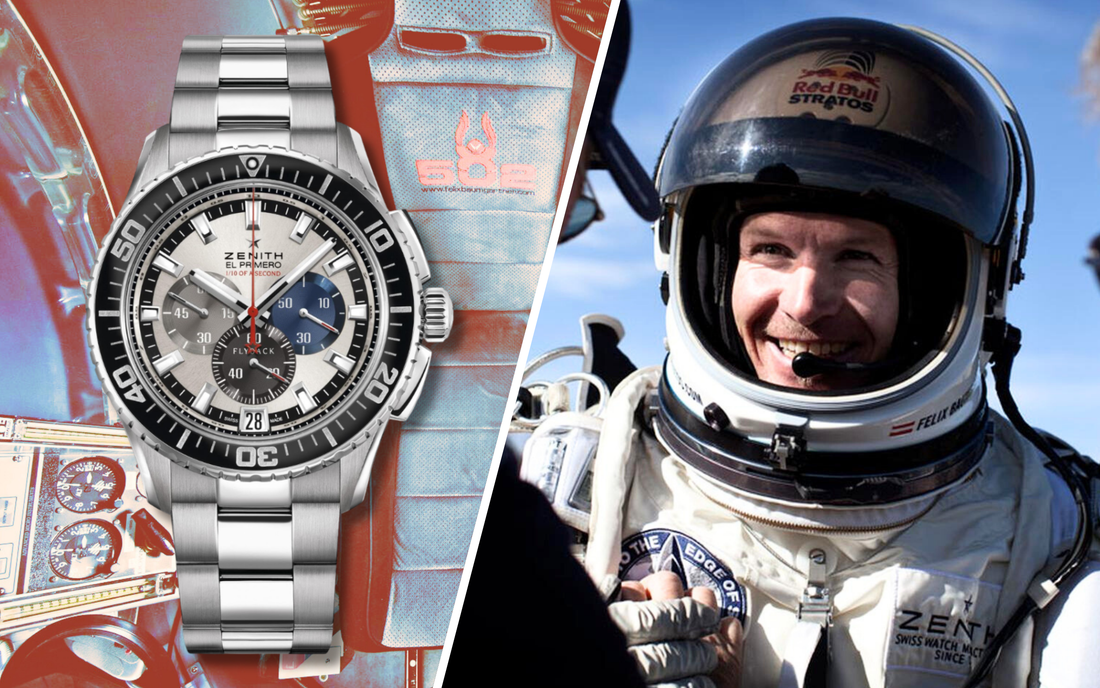What Can A Tragic Accident Teach Us About The Watch Industry & The Risks Of Exploration?
By Benjamin Lowry
On 14 October 2012, Felix Baumgartner cemented his place in history when he leaped from a capsule suspended from a massive helium balloon, falling 24 miles (39 kilometers) to the Earth’s surface and breaking several world records in the process. Equipped with a spacesuit and a special Zenith watch, Baumgartner’s skydive catapulted him into the limelight, making the Austrian daredevil a household name and a high-flying viral marketing vehicle.
Earlier this month, Baumgartner, aged 56, tragically died instantly when he reportedly fell unconscious in midair and flew a motorized paraglider into the side of a pool near the Italian coast. The first person to break the sound barrier outside of a vehicle, he was also known for setting skydiving records for exit altitude, vertical freefall distance, and vertical speed. Baumgartner lived a remarkable life and embodied the “Use Your Tools” ethos. His passing is a significant loss for the community.
A longtime partner with Zenith, the former Austrian military parachutist’s sensational exploits and tragic death are a case study in living life on the edge and using that position of prominence to influence consumer behavior, a once common marketing tactic in the watch industry and beyond.
Red Bull Stratos & Zenith

Red Bull Stratos was a big win for Red Bull, Baumgartner, and Zenith, a brand that isn’t always in the W.O.E. conversation. (Photo Credit: Red Bull)
Baumgartner’s jump from the stratosphere back in 2012 was equal parts daring human endeavor and carefully coordinated marketing effort. For daredevils, divers, extreme sports athletes, and explorers, the reality is that world records are often accompanied by a staggering financial burden, and sponsors are often a key component of making such stunts and expeditions possible.
Red Bull is unique, and in stark contrast to most watch brands, in that virtually all of its marketing is done in this way, partnering with extreme athletes and events rather than buying billboards in Times Square showing off an updated can design. Still, even by Red Bull’s standards, Stratos had to be expensive. According to The Times, Baumgartner’s Stratos jump was executed to the tune of $30M, with an unspecified amount likely funded by Zenith watches. Was it worth it?

It may not be to our taste, but the watch produced after Baumgartner’s Stratos jump shows Zenith’s level of investment. (Photo Credit: Horobox)
With some 8M viewers watching the event live on YouTube, a record number at the time, coupled with millions of shares across social media, not to mention Felix’s safe return to Earth and successful completion of the objective, Stratos was a resounding success, not only for Red Bull but also Zenith, a watch brand few would have expected to shell out the big bucks for a spot on Baumgartner’s wrist. After the successful jump, Zenith even commissioned and marketed a special watch that broke the sound barrier, complete with Felix's face on the caseback.
Zenith & The El Primero Chronograph

Zenith’s Chronomaster Original is among the brand’s most popular modern watches, calling back to a time when Zenith sponsored adventures and expeditions for marketing’s sake. (Photo Credit: Zenith)
In 2012, the watch industry was a markedly different place. Tudor’s ascent to become the modern tool watch leader was in its infancy, with the Black Bay and Pelagos having been unveiled only six months before Stratos took place, well before the industry-wide “vintage-inspired” craze Tudor helped to launch. Back then, a Rolex Submariner still measured 40mm in diameter (as God intended), luxury watches weren’t roasted on Reddit for having ETA base calibers, and a perfectly reasonable power reserve was still around 40 hours. They were different and simpler times.
Of all the watch brands one might have expected to partner with a big money event like Stratos, Zenith, a brand we’ve hardly mentioned on W.O.E., might not have been anyone’s guess. It may not be at the forefront of the Use Your Tools conversation today, but Zenith’s laurels are well-deserved, having been founded in 1865 and best known for the El Primero series of chronographs that launched in 1969 with a motorsport focus. Known for the quality and precision of its in-house chronograph calibers, Zenith even provided movements for Rolex to use in the Daytona for over a decade. So-called “Zenith Daytona” models are highly collectible.
Zenith - Selling Watches With Adventure

Zenith has long been interested in feats of aviation, including in 1970 when an A385 Chronograph was strapped near the landing gear of an Air France 707 for a flight from New York to Paris.
When Felix Baumgartner strapped on the El Primero Stratus Flyback Striking 10th for the Stratos jump, it was the culmination of a relationship that started in 2010 when then-Zenith exec Jean-Frédéric Dufour (now CEO of a brand called Rolex) first met Baumgartner. For watch brands, the practice of supporting this kind of feat is now seldom-seen, with many instead focused on sailing, tennis, golf, and other luxury-adjacent pursuits that are inherently safer, at least compared to falling from the stratosphere.
Zenith has a proud tradition of sponsoring adventures, at least back in the day, including Roald Amundsen’s expeditions to the Poles in the early 1900s, Louis Blériot’s English Channel crossing flight in 1909, and even a publicity ride by an A385 chronograph on the landing gear of a Boeing 707 during a flight from Paris to New York in 1970.
Sponsoring Stratos might have felt like a rare move for modern Zenith, but it was in keeping with the company’s long-standing ethos and exemplary of an approach often implemented by the broader watch industry during the 20th Century.
The Golden Age Of Watch Marketing

Longines and Favre-Leuba partnered with French Arctic explorer Paul-Emile Victor, the antithesis of most modern “influencers”. (Photo Credit: Longines)
We’ve discussed celebrity marketing in the watch industry before, and suffice it to say that in the mid-century, brands saw legitimate value in partnering with explorers, pilots, and divers rather than the vapid celebrities, mainstream athletes, or K-Pop superstars they tend to favor today. Back then, being famous mattered, but so did the reason for the fame. Influential individuals like pilots Chuck Yeager and Charles Lindbergh or diver and filmmaker Jacques Cousteau partnered with watchmakers looking for influence based on the appeal of pushing the boundaries.
If you weren’t already famous, the pursuit of something objectively cool and extreme, whether skiing alone to the South Pole or diving into the ocean depths in a submersible, was also typically enough to get watch brands and consumers hot and bothered. Take, for example, Rolex’s involvement in bathyscaphe Trieste’s dives to the ocean’s deepest point, Tudor’s sponsorship of the British North Greenland Expedition, or Longines and later Favre-Leuba’s sponsorship of French explorer Paul-Emile Victor’s polar efforts. If marketing of this type was so effective back then, what changed? And where does Felix Baumgartner come in?
Modern Watch Marketing & Risk Mitigation

A 1967 Rolex ad featuring a Submariner worn by a US Navy Submarine Officer onboard the USS Skate.
Whether we like it or not (we don’t), explorers and divers simply aren’t as influential as they once were, and as the role played by watches has shifted from utilitarian tool to luxury accessory for most consumers, brands seldom consider expensive adventures a good investment. Modern marketing departments want engagement, impressions, eyeballs, click-through, and often above all, to be perceived as luxurious, part of an aspirational lifestyle. Solo skiing to the North Pole is incredible, sure, but is it luxury?
Notably, Rolex still sponsors a number of expeditions, and smaller brands like Bremont and others still sometimes lean into adventure-based marketing on a smaller scale. However, by and large, it’s easier, cheaper, and more effective to partner with mainstream celebrities, athletes, and sexy twenty-something Instagram influencers to sell watches than it is to fund expeditions and extreme stunts that pose serious physical risks to those involved, as well as the risk of losing control of the almighty narrative. Felix Baumgartner’s untimely death proves that life on the edge sometimes ends in tragedy, negative PR that most brands can’t afford.

(Photo Credit: Red Bull)
Imagine if Baumgartner had burned in during the Stratos jump. Instead of a marketing coup for Red Bull and Zenith, it would have been a tragic loss of both life and ad revenue, a harsh reality and level of risk most brands can’t or won’t accept, especially when the modern celebrity/influencer route works as well as it does.
Final Thoughts
Felix Baumgartner’s death is a gut check, not just for adrenaline junkies and would-be explorers, but for the watch industry itself. It reminds us that real adventure comes with real risk, and that the stories worth telling often aren’t curated, sanitized, or Instagram-friendly. Zenith bet big on Stratos, and it paid off, but that kind of gamble is now mostly a relic of a different era, when watches were sold not through filters and hashtags but through grit, danger, and the sex appeal of expanding the boundaries of the unknown.
As luxury watch brands retreat to the comfort of Swiss boardrooms, curated “activations,” and safe celebrity or influencer tie-ins, we’re left to wonder if anyone still has the nerve to put their name on something that might not end in applause. Baumgartner did. Zenith did. And in a world increasingly obsessed with control, maybe that’s what makes their story worth remembering.

(Photo Credit: Red Bull)
This Dispatch is dedicated to the memory of Felix Baumgartner’s remarkable life and passion for expanding the limits of what is considered possible.
If you enjoyed this article, please consider signing up for our weekly free newsletter for further updates HERE.
Read Next: The Watch Industry & Celebrity Marketing Through the Ages









18 comments
I also think that in the mid-century, the watches were actually used or relied upon for the adventure or expedition. The marketing is then perfect, when they can say “Look! Our watch helped make this possible.” With today’s technology, you don’t have to always rely on that watch and most are reliable enough, so it changes the actual marketing purpose.
Is it true that Abdullah Öcalan used a Zenith watch when he was arrested ?
The marketing for this was pretty cool considering we’re still talking about it 13 years later. Two years after this jump Allen Eustace broke the record wearing a Sinn 857 UTC on his suit, unbeknownst to Sinn (and pretty much everyone else). It’s interesting how differently the two jumps were handled from a pr/marketing standpoint. Two fantastic timepieces though.
That Zenith really is a beautiful watch…
Fantastic article. Especially in a world where increasingly, for the majority of people, if you’re wearing anything more than a G-Shock the ethos of ‘use your tools’, to quote W.O.E., is seen as an anathema.
@H – I believe you answered your own question. Had Chuck Yeager had a GMT Master strapped to the outside of his Bell X-1 when he broke the sound barrier, then the Zenith wouldn’t be the first. The key here is that it broke the sound barrier on the outside of Felix’s spacesuit, in open air, while he himself became the first person to break the sound barrier outside a vehicle. They’re very different things.
Consider the Rolex Deepsea; capable of ticking comfortably away at the Titanic but outside a submersible. Any watch can, and many have, reached that depth inside a craft in the same way as literally thousands of watches have been faster than the speed of sound on the wrists of pilots, astronauts and Concorde passengers but not outside the craft. That’s the crucial distinction.